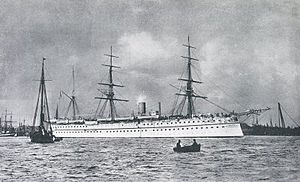HMS Malabar (1866)

| |
| History | |
|---|---|
| Name | HMS Malabar |
| Ordered | 1865 |
| Builder | Thames Shipbuilding Co., Leamouth, London[3] |
| Yard number | 120 |
| Launched | 8 December 1866[Note 1][1][2] |
| Fate |
|
| General characteristics | |
| Class and type | Euphrates-class troopship |
| Type | Troopship |
| Displacement | 6,186 tons, 4,189 tons BM[3] |
| Length | 360 ft (109.7 m) (overall) |
| Beam | 49 ft 0.75 in (15.0 m) |
| Depth of hold | 22 ft 4 in (6.81 m) |
| Installed power |
|
| Propulsion |
|
| Sail plan | Barque |
| Speed | 15 kn (28 km/h) |
| Armament | Three 4-pounder guns |
HMS Malabar was a Euphrates-class troopship launched in 1866, and the fifth ship of the Royal Navy to employ the name. She was designed to carry troops between the United Kingdom and British India, and was employed in that role for most of her life. She became the base ship (or depot ship) at the Royal Naval Dockyard, Bermuda in 1897 (replacing the previous depot ship, ), was renamed HMS Terror in 1901 and was sold in 1918. Her name was later used as the stone frigate to which shore personnel in Bermuda were enrolled, and later for Her Majesty's Naval Base Bermuda, after the 1950s, when the dockyard was reduced to a base.
Design[]
Malabar was one of five iron-hulled vessels of the Euphrates class. All five were built to a design of 360 ft overall length by about 49 ft breadth, although Malabar was very slightly smaller than the rest of the class. They had a single screw, a speed of 14 knots, one funnel, a barque-rig sail plan, three 4-pounder guns, and a white painted hull. Her bow was a "ram bow" which projected forward below the waterline.
Identification[]
The Euphrates-class troopships could each be identified by a different coloured hull band. The Malabar's hull band was black. The blue hull band of her sister Euphrates became the standard for all HM Troopships.[4]
Career[]
She was built for the transport of troops between the United Kingdom and the Indian sub-continent, and was operated by the Royal Navy. She carried up to 1,200 troops and family on a passage of approximately 70 days.
In common with her sisters she was re-engined, her single-expansion steam engine being replaced with a Napier 2-cylinder compound-expansion engine in 1873.[3]
On 2 November 1878, she suffered an engine breakdown in the English Channel 17 nautical miles (31 km) east south east of Prawle Point, Devon whilst on a voyage from Portsmouth, Hampshire to India. She was taken in tow by the steamship Benjamin Whitworth, which with the assistance of two Admiralty tugs took her in to Plymouth, Devon.[5] In 1878 or early 1879 she grounded in Whitsand Bay near Plymouth. Her commanding officer, Captain Percy Luxmoore, was dismissed from the ship and replaced by Captain John Grant.[2]
Fate[]
She became the base ship at Bermuda in 1897 and was renamed HMS Terror on 1 May 1905; the name Malabar was later used by the Royal Naval dockyard at Bermuda. Terror was sold in January 1918.[3]
Commanding officers[]

| From | Until | Captain[2] |
|---|---|---|
| 22 March 1867 | 13 February 1870 | Captain Frederic Dampier Rich |
| 14 February 1870 | 21 August 1872 | Captain Sholto Douglas |
| 17 October 1872 | 10 September 1874 | Captain Thomas Baker Martin Sulivan |
| 10 September 1874 | 26 October 1874 | Captain Edward Thomas Nott (died in command) |
| 30 October 1874 | Captain Edward Kelly | |
| 27 April 1878 | 8 February 1879 | Captain Percy Patt Luxmoore |
| 8 February 1879 | Captain John Frederick George Grant | |
| August 1887 | Early 1890 | Captain Arthur Dalrymple Fanshawe |
Notes[]
- ^ Although Winfield has 1865, this is a misprint and should read 1866. Copies of the Errata may be requested from the author.
References[]
- ^ Colledge, J. J.; Warlow, Ben (2006) [1969]. Ships of the Royal Navy: The Complete Record of all Fighting Ships of the Royal Navy (Rev. ed.). London: Chatham Publishing. ISBN 978-1-86176-281-8.
- ^ a b c "HMS Malabar at William Loney RN website". Retrieved 23 June 2009.
- ^ a b c d e Winfield, R.; Lyon, D. (2004). The Sail and Steam Navy List: All the Ships of the Royal Navy 1815–1889. London: Chatham Publishing. ISBN 978-1-86176-032-6.
- ^ The Royal Navy at Malta, Volume One: The Victorian Era - 1865-1906, page 51, by Richard Ellis & Lt. Cdr. Ben Warlaw RN - ISBN 0907771432
- ^ "Shipping". Daily Gazette for Middlesbrough. No. 3552. Middlesbrough. 4 November 1878. p. 4.
- Troop ships of the Royal Navy
- Euphrates-class troopships
- Ships built in Leamouth
- Victorian-era naval ships of the United Kingdom
- 1866 ships
- Maritime incidents in November 1878